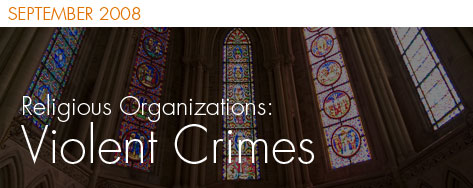|
|
|
Missing the Last Piece to Your Risk Management Solution?
|
|
|
|
Our custom Training Services will give you many benefits.
|
|
|
|
The possibilities are endless with Phly Loss Control.
|
|
|
|
|
|
|
|
|
|

Religious Organizations violence has captured national attention with the following tragic events:
Knoxville, TN July 2008: A man opened fire at a church. Two people were killed and six others were injured. Police are investigating the shooting as a possible hate crime. According to the Free-Lance Star, this is the 17th major church shooting in the United States since 1998.
Denver, CO December 2007: A gunman killed two at a missionary training center. The next day, he killed two more people at a Colorado Springs mega church. An armed guard at the church shot the gunman.
Neosho, MO August 2007: A gunman opened fire at a church killing a pastor and two worshipers and wounding several others.
Moscow, ID May 2007: A gunman killed a police officer and a church leader before killing himself.
In response to these events, increased vigilance and attention to places of worship have served parishioners well. Many places of worship have applied the lessons learned from such violent incidents. As a result, they have prepared for worse case scenarios and are engaged regularly in the process of planning for safe facilities, crisis response and crisis recovery. Other strategies include:
- Conducting a comprehensive risk management assessment;
- Establishing law enforcement and education partnerships;
- Training;
- Engaging in drills and practice
Steps to a Safer House of Worship “Reducing Vulnerability”
There is no amount of planning that can stop someone from desiring to harm others. Having a plan of prevention and response can make your congregation a more difficult target and can reduce the harm if violence occurs.
- Maintain vigilance & do not become complacent - Most of these cases involve individuals that have a relationship with the congregation. These individuals traditionally have a history of non-violent altercations prior to the event.
- Review screening policies for visitors, volunteers, workers and service personnel - Be aware of individuals who are "rule followers" will abide by the rules and directional signs for visitor check in. Those who intend to do harm will circumvent screening procedures. Train personnel regarding non-confrontational methods for approaching strangers. Direct them to report all unknown persons who are in the building.
- Criminal background checks and abuse registry checks - Should be completed on all staff and volunteers working with vulnerable people.
- Assess the public’s access to your building - How easy is it for intruders to gain access? How are vehicle and pedestrian access controlled? What non-traditional functions provide additional access to your site?
- Building Perimeter Intrusion - Entrances into the congregation should be limited during service and non service hours. All doors should be equipped with panic hardware for safe exiting. During services, greeters and team members should be positioned near entrances with means of communication in the event a distressed or suspected high risk individual should enter. Code words should be used to activate the emergency plan.
- Emergency Preparedness Plan - Elements of the emergency and disaster plan should be customized to specifically address tasks before, during and after the event. This would include communications, emergency evacuation procedures, meeting place for evacuees, and emergency response procedures. The plan should outline and enable the use of internal resources and additional external resources at the time of emergency. Once the written plan is developed, implementation and training should be immediate. Ensure the emergency plan is tested and that it works. Complete emergency drills, audit and revise as necessary.
- Communications Process - Should have a “lockdown” code word via internal communication which would be activated if a threat was detected or weapons were spotted. Authorities should be contacted immediately.
- Key Response Team Members –In addition to designated staff, the program should invite any doctors, nurses, police officers, security personnel, firemen, EMT’s and other first responders from the congregation to become team members. These team members should review all crisis management policies and procedures and advise in their areas of expertise.
Internal Security Plan
- Congregation leaders, congregants, administrators and the public in general are becoming acutely aware of the need for improved protection for random acts of violence. Self-locking doors, key-cards, outdoor floodlights, perimeter fencing with "No Trespassing" signs, central-station alarm systems, closed-circuit video surveillance systems, and/or frequent public police patrols may not provide all the protection needed. Security forces have become more common place as risk managers become more concerned about their accountability in providing a safe environment.
- Security force workers can be directly employed by the congregation, volunteers, off duty police officers, or may be subcontracted to third party entities. Due to the limited expendable funds available to most congregations, paid security is generally not the norm.
Counsel should be obtained by congregation attorneys, local law enforcement professionals or insurance professionals prior to making decisions on whether do one or more of the following:
- Self perform and maintain own security staff
- Contract agreement with a security company
- Hiring off duty police officers
- Armed vs. unarmed security guards
When contracting with a security service the congregation should ensure the following:
- Reference checks should be completed on the firm. The congregation is responsible and within reason for making certain the firm has a strong criminal background check, education and training program.
- As part of the interview process, congregation administrators are responsible to verify all security staff meets and complies with all federal and local licensing certification requirements.
- Proper contractual risk transfer mechanisms should be in place.
Please click on the links below to help get your organization started, Philadelphia is offering the following free resources:
Risk Management Program
Crisis Management Self Audit Program
Security Power Point Presentation
Other Links
CHURCH SECURITY SERVICES
SECURITY NEWSPAPER ARTICLE
NATIONAL ORG OF CHURCH SECURITY AND RISK MGMT |
|
Contact Information
|
|
HOME OFFICE CONTACTS
|
|
Mark Konchan, ARM CSP
Vice President
Home Office – Bala Cynwyd, PA
Phone: (800) 873-4552
E-Mail: mkonchan@phlyins.com
Bill Mesure, Sr. Loss Control Consultant
(Mid-Atlantic Region)
Home Office – Bala Cynwyd, PA
Phone: (800) 873-4552
E-Mail: bmesure@phlyins.com |
|
REGIONAL OFFICE CONTACTS
|
|
Leslie Dugan, Assistant Vice President
(Sunbelt, Western, Northwest,
Rocky Mountain Regions)
Mission Viejo, CA
Phone: (800) 994-4121 ext. 236
E-Mail: ldugan@phlyins.com
Thomas Merritt, Loss Control Consultant
(Sunbelt, Western, Northwest Regions)
Mission Viejo, CA
Phone: (800) 994-4121 ext. 223
E-Mail: tmerritt@phlyins.com
Kenneth R Zimmerman, CSP
Regional Loss Control Manager
(Rocky Mountain)
Littleton, CO 80127
Phone: (866) 608.5898 ext. 5351
E-Mail: kzimmerman@phlyins.com
Brett Hines, Regional Loss Control Manager
(Central, Southwest Regions)
Independence, MO
Phone: (877) 439-7459
E-Mail: bhines@phlyins.com
Ron Quattrochi, Regional Loss Control Manager
(Northeast Region)
Stoughton, MA
Phone: (888) 292-3881 ext. 268
E-Mail: rquattrochi@phlyins.com
Scott Holt, Sr. Loss Control Consultant
(Metro Region)
Lawrenceville, NJ
Phone: (866) 586-6122 ext. 264
E-Mail: sholt@phlyins.com
George Kalule, Loss Control Consultant
(North Central Region)
Naperville, IL
Phone: (800) 547-9967 ext. 2256
E-Mail: gkalule@phlyins.com
Philip Azar, Sr. Loss Control Consultant
(Southeast, Florida Regions)
Kennesaw, GA
Phone:(770) 799-3067
E-Mail: pazar@phlyins.com
Rachael Marchini, Sr. Loss Control Consultant
(Ohio Valley Region)
Beachwood, OH
Phone: (866) 295-3042
E-Mail: rmarchini@phlyins.com
|
IMPORTANT NOTICE - The information and suggestions presented by Philadelphia
Indemnity Insurance Company in this E-Brochure is for your consideration in your loss prevention efforts.
They are not intended to be complete or definitive in identifying all hazards associated with your business,
preventing workplace accidents, or complying with any safety related, or other, laws or regulations. You are
encouraged to alter them to fit the specific hazards of your business and to have your legal counsel review
all of your plans and company policies.
|
|







